
Single Sex or Mixed Education: Decisions Decisions
There is rising pressure on toy manufacturers to make their playthings gender neutral so that girls don’t only play with dolls and pink stuff and boys don’t just wrestle with guns and non-pink stuff. Let toys be toys they say and let’s treat children the same. That’s all well and good except when it comes to education. More and more research shows that boys and girls learn differently and they can benefit by being taught separately.
The gender gap exists at every single stage of schooling. Last year the Department of Education found that when boys start school, they are outperformed by their female classmates in writing and Maths. At the other end of the spectrum, fewer men are going on to higher education. A report entitled Boys to Men: The Underachievement of Young Men in Higher Education and How to Start Tackling It, found that the proportion of males entering UK higher education institutions is at a record low.
Girls tend to develop communication skills earlier. By the age of three, 99% of girls can talk whereas boys take almost another year to reach the same level. Girls write sooner as boys are slower to develop the fine motor control needed to put pencil to paper. With an education system that focuses so heavily on literacy, these early differences mean boys start off at a disadvantage. A National Literacy Trust survey found that in 76% of schools, boys don’t do as well in reading as girls.
There are so many differences. Boys respond better to situations that involve physical activity, whereas girls are good at sitting still and listening. In contrast to girls, boys tend to act first and think later and so schools are working on thinking skills for males. Splitting up the sexes can also help overthrow stereotypes. Girls are not sunder pressure to compete with boys in the traditionally ‘male’ subjects of Maths and Science. Similarly boys can flourish in the more female-friendly Arts subjects. It’s even been found that girls like warmer classrooms while boys prefer cooler temperatures.
Of course not every child can be stereotyped as a ‘typical boy’ or ‘typical girl’ but any teacher knows differentiating between 20 or 30 pupils is hard enough, so taking advantage of general behavioural traits can make for a happier, higher-achieving classroom.
I was taught in a single sex school and found the absence of girls meant we didn’t show off (as much!) and didn’t get as distracted when the hormones knocked us for six in our teenage years. Maybe it helped us grow up quicker as in the Sixth Form we were treated like young men, not kids.
It didn’t mean we entered adulthood treating girls as though they were from outer space: there are plenty of opportunities to mingle outside of the classroom. Many single sex schools partner opposite sex schools nearby – such as Loughborough Grammar and Loughborough High School. Some Sixth Form classes are mixed and the schools unite for sports and theatre productions. When it comes to toys, let’s mix and match but with education, I think it’s good to go it alone.
